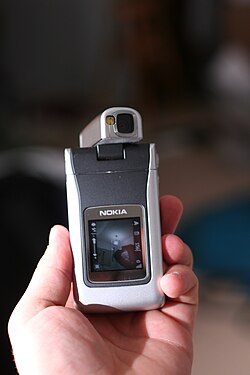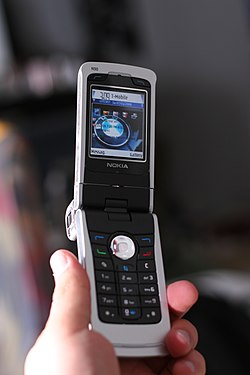This article needs additional citations for verification. (December 2009) |
 | |
| Manufacturer | Nokia |
|---|---|
| Availability by region | 2005 |
| Predecessor | Nokia 6260 |
| Successor | Nokia N93 |
| Related | Nokia N70 Nokia N71 Nokia N72 Nokia N80 Nokia N91 Nokia N92 |
| Compatible networks | GPRS, EDGE, WCDMA |
| Form factor | Clamshell |
| Dimensions | 112x51x24 mm |
| Weight | 173 g |
| Operating system | Symbian OS v8.1a, Series 60 Feature Pack 3 |
| CPU | TI OMAP 1710, 32-bit RISC ARM9 @ 220 MHz |
| Memory | 48 MB |
| Removable storage | DV RS-MMC / MMC-Mobile |
| Battery | BL-5B, 3.7 V, 760 mAh |
| Rear camera | 2 Megapixels |
| Display | TFT, 262,144 colours, 352×416 pixels |
| External display | TFT, 65,536 colours, 128×128 pixels |
| Connectivity | USB (v2.0), Bluetooth (v1.2) |
| Data inputs | Keypad |


The Nokia N90 is a mobile phone, announced as part of Nokia's then-new line of multimedia devices, Nseries, on April 27, 2005.[1] It had a unique swivel design encompassing four 'modes'. It has two displays and has a camera with Carl Zeiss optics and integrated flash, and can record video with audio. The screen can be swiveled 270° to mimic the appearance of a camcorder. The camera lens can also be swiveled. The 2.1-inch display has a pixel density of 259 ppi, considered the most crispest Nokia screen at the time, and continued to be joint-highest with the N80, E60 and E70 for four years, before being beaten by the Nokia N900 in 2009 with 267 ppi. The Nokia N90 can print with some printers over USB or over Bluetooth.[2]
It uses the Series 60 2nd Edition, Feature Pack 3 user interface on top of the Symbian OS 8.1a operating system. Later revisions also shipped with Version 2 of the Nokia Lifeblog software. The Nokia N90 began shipping in Q2 2005 in most markets, but didn't appear in the US until Q1 2006. It was succeeded by the Nokia N93.
The N90 was usually bundled with a 64 MB or 128 MB DV-RS-MMC memory card and a USB data transfer cable.
Complaints about the N90 include high price, large size, weight, and "chunkiness."
- ^ "Twist and Shoot: Nokia N90 makes its première | Nokia". Archived from the original on 2014-07-14.
- ^ "Sell Nokia N90 for up to £1, ⇒ Compare Recycler Prices". Archived from the original on 2018-03-08. Retrieved 2018-03-07.